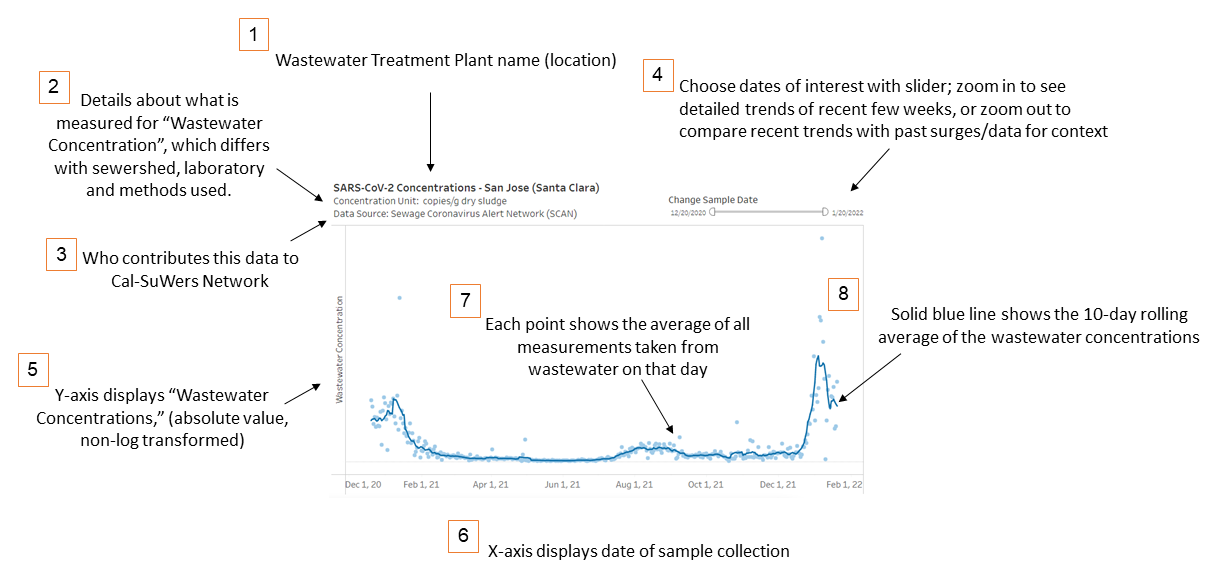Instructions for using this dashboard:
Details
By selecting a sewershed (which includes the wastewater treatment plant service areas), you can see the SARS-CoV-2 RNA concentrations in wastewater for that location over time. Information about where the wastewater samples are taken are displayed at the top of the graph, as are details about which Cal-SuWers Network partner is contributing the data.
The x-axis represents the date of sample collection (the day the wastewater samples were collected from the site). The y-axis represents the SARS-CoV-2 concentration or amount of virus present per sample. As different laboratory and sample collection methodologies are used at different sites, "wastewater concentration" represents a different measurement at different locations, and absolute values are not displayed. See details about what is being measured underneath the location name at the top of the graph. Because different methodologies are used at different sites, direct comparisons of wastewater concentration values from different locations are discouraged.
As of July 5, 2022, SARS-CoV-2 concentrations for DWRL are now reported as normalized to a human fecal indicator, rather than raw SARS-CoV-2 concentrations. Currently, the human fecal indicator being measured at our contributing laboratories is Pepper Mild Mottle virus (PMMoV), a plant RNA virus that is abundant in human feces and rarely found in animal feces. This plant virus can be found in the diets of most healthy human populations and is considered a reliable indicator for the presence of human feces in a wastewater sample1. Human fecal indicators are measured to provide insight into the number of people contributing to a sewershed at any given time, and human fecal normalization may allow for clearer interpretation of SARS-CoV-2 concentrations2.
CDPH analyses of DWRL wastewater data show improved correlation with case incidence rates after normalization to PMMoV (SARS-CoV-2/PMMoV), as compared to raw SARS-CoV-2 (copies/L wastewater) data. Additionally, our SCAN partner laboratory had similar findings and their data is presented as normalized to PMMoV. However, other contributing laboratories prefer raw concentrations to be reported, as they either do not measure PMMoV or have not found an improvement with normalization. As such, whether raw or normalized concentrations are reported varies from laboratory to laboratory. Description of whether a normalized or raw concentration is presented is located in text at the top of the concentration graph ("Concentration Unit").
The
full dataset, containing raw concentrations for all data sources, can be accessed from the
California Open Data Portal. Normalized data can be manually calculated – if desired – by the following equation in the California Open Data Portal dataset:

The dots on the graph display the average concentration for all wastewater samples collected on that date. The line represents a 10-day rolling average of the wastewater data. The 10-day rolling average is added to help guide the eye to trends in the data.

(click image to enlarge)
Cal-SuWers Graph Guide (PDF)
Data Limitations:
Wastewater surveillance for viral detection is still a developing field. Below are some important considerations to keep in mind.
- It is not possible to reliably and accurately predict the total number of infected individuals in a community based on sewage surveillance alone.
- Wastewater surveillance will not represent homes on septic-based systems.
- Community-level wastewater surveillance at a wastewater treatment plant will not represent communities or facilities served by decentralized systems, such as prisons, universities, or hospitals that treat their own sewage.
- Low levels of infection in a community may not be captured by sewage surveillance if the quantity of SARS-CoV-2 falls below the limit of detection for laboratory analysis.
- Wastewater is a complex environmental sample and inherent variability in measured concentrations are expected due to environmental variability, day-to-day differences in sewershed and population dynamics, and laboratory variability. As such, trends (>3 data points) are more reliable than individual data points; concentration of any individual data point may reflect variability and should be interpreted in appropriate context and with caution.